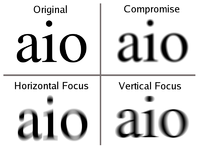
Photo from wikipedia
PURPOSE To compare standard and total corneal astigmatism measurements to the predicted pseudophakic (non-toric) refractive astigmatism in candidates for cataract surgery. DESIGN A retrospective, cross-sectional study. METHODS A single-center analysis… Click to show full abstract
PURPOSE To compare standard and total corneal astigmatism measurements to the predicted pseudophakic (non-toric) refractive astigmatism in candidates for cataract surgery. DESIGN A retrospective, cross-sectional study. METHODS A single-center analysis of consecutive eyes measured with an SS-OCT biometer at a large tertiary medical center between February 2018 and June 2020. Corneal astigmatism was calculated based upon standard keratometry astigmatism (KA), total corneal astigmatism (TCA), and predicted refractive astigmatism (PRA) for a monofocal non-toric intraocular lens (IOL) implantation calculated by the Barrett toric calculator using the predicted posterior corneal astigmatism (PRA(Predicted-PCA)) and the measured posterior corneal astigmatism (PRA(Measured-PCA)) options. Separate analyses were performed for each eye. SETTING Ophthalmology Department, Shaare Zedek Medical Center, Jerusalem, Israel. RESULTS In total, 8152 eyes of 5320 patients (4221 right eyes [OD] and 3931 left eyes [OS], mean age 70.6±12.2 years, 54.2% females) were included in the study. The mean vector values (centroid) for KA, TCA, PRA(Predicted-PCA), and PRA(Measured-PCA) were OD (0.07 diopters [D] @ 19.5°, 0.27 D @ 7.5°, 0.44 D @ 2.9°, and 0.43 D @ 179.3°, respectively, P <.01), and OS (0.02 D @ 150.3°, 0.23 D @ 169.7°, 0.40 D @ 179.4° and 0.42 D @ 169.5°, respectively, P <.01). More than 73% of eyes had a PRA >0.5 D. CONCLUSIONS Standard and total corneal astigmatism measurements differ significantly from the predicted refractive astigmatism by the Barrett toric calculator. The PRA, rather than the KA or TCA, should be used as the reference guide for astigmatism correction with toric IOL implantation.
Journal Title: American journal of ophthalmology
Year Published: 2022
Link to full text (if available)
Share on Social Media: Sign Up to like & get
recommendations!